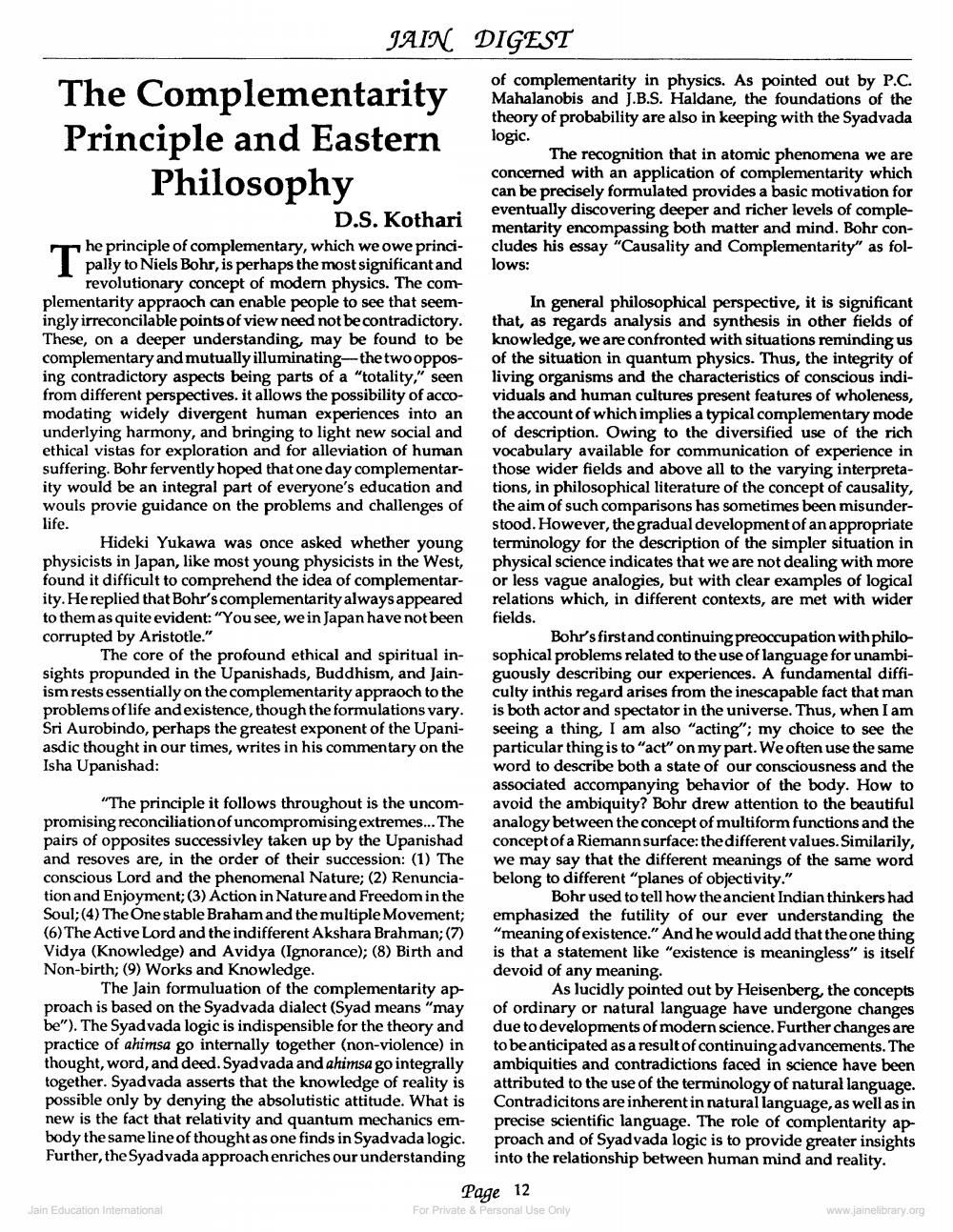________________
JAIN DIGEST The Complementarity Principle and Eastern
Philosophy
life.
of complementarity in physics. As pointed out by P.C. Mahalanobis and J.B.S. Haldane, the foundations of the theory of probability are also in keeping with the Syadvada logic.
The recognition that in atomic phenomena we are concerned with an application of complementarity which can be precisely formulated provides a basic motivation for
eventually discovering deeper and richer levels of compleD.S. Kothari
mentarity encompassing both matter and mind. Bohr conhe principle of complementary, which we owe princi- cludes his essay "Causality and Complementarity" as folpally to Niels Bohr, is perhaps the most significant and lows:
revolutionary concept of modern physics. The complementarity appraoch can enable people to see that seem
In general philosophical perspective, it is significant ingly irreconcilable points of view need not be contradictory. that, as regards analysis and synthesis in other fields of These, on a deeper understanding, may be found to be knowledge, we are confronted with situations reminding us complementary and mutually illuminating--the two oppos- of the situation in quantum physics. Thus, the integrity of ing contradictory aspects being parts of a "totality," seen living organisms and the characteristics of conscious indifrom different perspectives. it allows the possibility of acco- viduals and human cultures present features of wholeness, modating widely divergent human experiences into an the account of which implies a typical complementary mode underlying harmony, and bringing to light new social and of description. Owing to the diversified use of the rich ethical vistas for exploration and for alleviation of human vocabulary available for communication of experience in suffering. Bohr fervently hoped that one day complementar- those wider fields and above all to the varying interpretaity would be an integral part of everyone's education and tions, in philosophical literature of the concept of causality, wouls provie guidance on the problems and challenges of the aim of such comparisons has sometimes been misunder
stood. However, the gradual development of an appropriate Hideki Yukawa was once asked whether young terminology for the description of the simpler situation in physicists in Japan, like most young physicists in the West, physical science indicates that we are not dealing with more found it difficult to comprehend the idea of complementar- or less vague analogies, but with clear examples of logical ity. He replied that Bohr's complementarity always appeared relations which, in different contexts, are met with wider to them as quite evident: "You see, we in Japan have not been fields. corrupted by Aristotle."
Bohr's first and continuing preoccupation with philoThe core of the profound ethical and spiritual in- sophical problems related to the use of language for unambisights propunded in the Upanishads, Buddhism, and Jain- guously describing our experiences. A fundamental diffiism rests essentially on the complementarity appraoch to the culty inthis regard arises from the inescapable fact that man problems of life and existence, though the formulations vary. is both actor and spectator in the universe. Thus, when I am Sri Aurobindo, perhaps the greatest exponent of the Upani- seeing a thing, I am also "acting"; my choice to see the asdic thought in our times, writes in his commentary on the particular thing is to "act" on my part. We often use the same Isha Upanishad:
word to describe both a state of our consciousness and the
associated accompanying behavior of the body. How to "The principle it follows throughout is the uncom- avoid the ambiquity? Bohr drew attention to the beautiful promising reconciliation of uncompromising extremes... The analogy between the concept of multiform functions and the pairs of opposites successivley taken up by the Upanishad concept of a Riemann surface: the different values. Similarily, and resoves are, in the order of their succession: (1) The we may say that the different meanings of the same word conscious Lord and the phenomenal Nature; (2) Renuncia- belong to different "planes of objectivity." tion and Enjoyment; (3) Action in Nature and Freedom in the
Bohr used to tell how the ancient Indian thinkers had Soul; (4) The One stable Braham and the multiple Movement; emphasized the futility of our ever understanding the (6) The Active Lord and the indifferent Akshara Brahman; (7) "meaning of existence." And he would add that the one thing Vidya (Knowledge) and Avidya (Ignorance); (8) Birth and is that a statement like "existence is meaningless" is itself Non-birth; (9) Works and Knowledge.
devoid of any meaning. The Jain formuluation of the complementarity ap
As lucidly pointed out by Heisenberg, the concepts proach is based on the Syadvada dialect (Syad means "may of ordinary or natural language have undergone changes be"). The Syadvada logic is indispensible for the theory and due to developments of modern science. Further changes are practice of ahimsa go internally together (non-violence) in to be anticipated as a result of continuing advancements. The thought, word, and deed. Syadvada and ahimsa go integrally ambiquities and contradictions faced in science have been together. Syadvada asserts that the knowledge of reality is attributed to the use of the terminology of natural language. possible only by denying the absolutistic attitude. What is Contradicitons are inherent in natural language, as well as in new is the fact that relativity and quantum mechanics em- precise scientific language. The role of complentarity apbody the same line of thought as one finds in Syadvada logic. proach and of Syadvada logic is to provide greater insights Further, the Syadvada approach enriches our understanding into the relationship between human mind and reality.
Page 12 Jain Education Intemational For Private & Personal Use Only
www.jainelibrary.org




